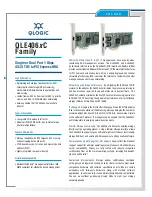
348 Optimizing fabric behavior
•
Use care if defining TI zones with ports that are shared across Admin Domains because of the limitation
that a given port can appear in only one TI zone.
Best practice:
Do not use ports that are shared across Admin Domains in a TI zone.
Virtual Fabric considerations for Traffic Isolation Routing
This section describes how TI zones work with Virtual Fabrics. See Chapter 6, ”
Managing virtual fabrics
”
on page 173 for information about the Virtual Fabrics feature, including Logical Switches and Logical
Fabrics.
TI zones can be created in a Logical Fabric like in regular fabrics, with the following exceptions:
•
The disable failover option is not supported in Logical Fabrics that use XISLs.
•
To create a TI zone for a Logical Fabric that uses XISLs, you must create two TI zones: one in the Logical
Fabric and one in the base fabric. The combination of TI zones in the base fabric and Logical Fabric
sets the path through the base fabric for Logical Switches.
The TI zone in the Logical Fabric includes the extended XISL (XISL) port numbers, as well as the F_Ports and
ISLs in the Logical Fabric.
The TI zone in the base fabric reserves XISLs for a particular Logical Fabric. The base fabric TI zone should
also include ISLs that belong to Logical Switches participating in the Logical Fabric.
Figure 50
shows an initiator and target in a Logical Fabric (FID1). The dotted line indicates a dedicated
path between initiator and target. The dedicated path passes through the base fabric over an XISL.
(
Figure 50
shows only physical ISLs, not logical ISLs.) To create the TI zones for this dedicated path, you
must create a TI zone in the Logical Fabric (FID1) and one in the base fabric.
Figure 50
Dedicated path with Virtual Fabrics
Figure 51
shows a logical representation of FID1 in
Figure 50
. To create the dedicated path, you must
create and activate a TI zone in FID1 that includes the circled ports shown in
Figure 51
.
Figure 51
Creating a TI zone in a Logical Fabric
= Dedicated Path
Chassis 1
Chassis 2
XISL
XISL
XISL
XISL
Domain 8
Domain 7
Base switch
Domain 2
LS2, FID3
Domain 6
LS1, FID1
Domain 5
Base switch
Domain 1
LS4, FID3
Domain 4
LS3, FID1
Domain 3
Domain 9
2
4
= Ports in the TI zones
6
7
12
1
8
5
3
8
17
15
16
14
13
11
10
9
Host
Target
= Dedicated Path
2
4
= Ports in the TI zones
6
7
5
17
16
11
10
8
1
3
8
9
Host
Domain 8
Domain 3
Domain 5
Domain 9
Target
Summary of Contents for A7533A - Brocade 4Gb SAN Switch Base
Page 1: ...HP StorageWorks Fabric OS 6 2 administrator guide Part number 5697 0016 Edition May 2009 ...
Page 24: ...24 ...
Page 99: ...Fabric OS 6 2 administrator guide 99 ...
Page 100: ...100 Managing user accounts ...
Page 118: ...116 Configuring standard security features ...
Page 164: ...162 Configuring advanced security features ...
Page 234: ...232 Installing and maintaining firmware ...
Page 268: ...266 Administering advanced zoning ...
Page 284: ...282 Configuring Enterprise class platforms ...
Page 292: ...290 Routing traffic ...
Page 294: ...292 Interoperability for merged SANs ...
Page 302: ...300 Configuring the Distributed Management Server ...
Page 334: ...332 iSCSI gateway service ...
Page 340: ...338 Administering NPIV ...
Page 407: ...Fabric OS 6 2 administrator guide 405 ...
Page 408: ...406 Using the FC FC routing service ...
Page 438: ...434 Administering extended fabrics ...
Page 460: ...456 Administering ISL trunking ...
Page 516: ...512 FICON fabrics ...
Page 526: ...522 Configuring and monitoring FICON Extension Services ...
Page 540: ...536 Configuring the PID format ...
Page 544: ...540 Understanding legacy password behavior ...
Page 546: ...542 Mixed fabric configurations for non merge SANs ...
Page 550: ...546 Migrating from an MP Router to a 400 MP Router ...
Page 558: ...554 Inband Management ...
Page 572: ...568 ...
















































